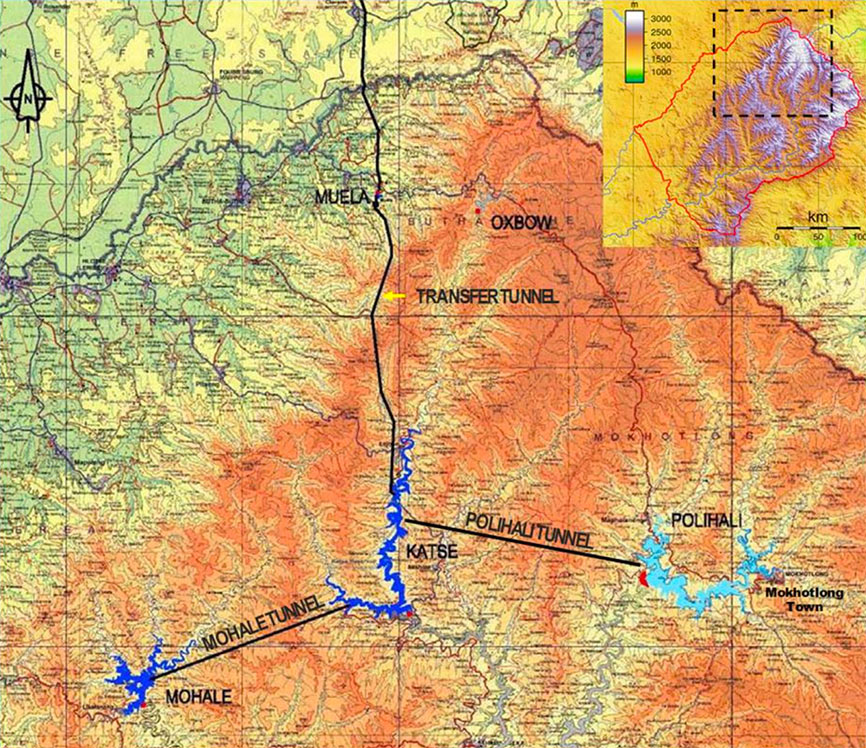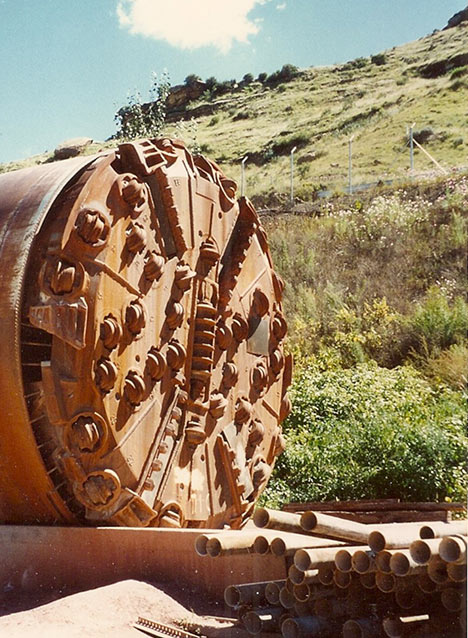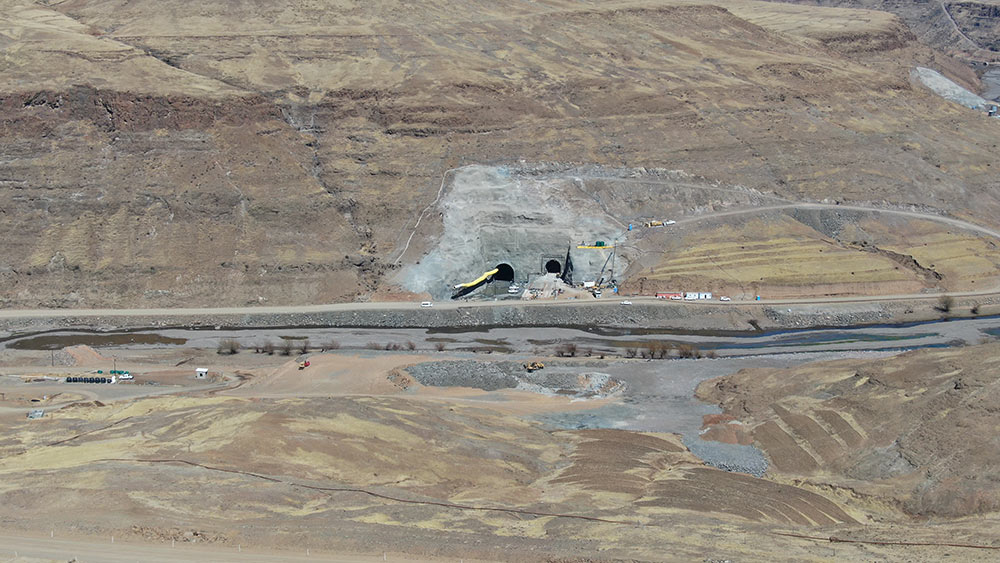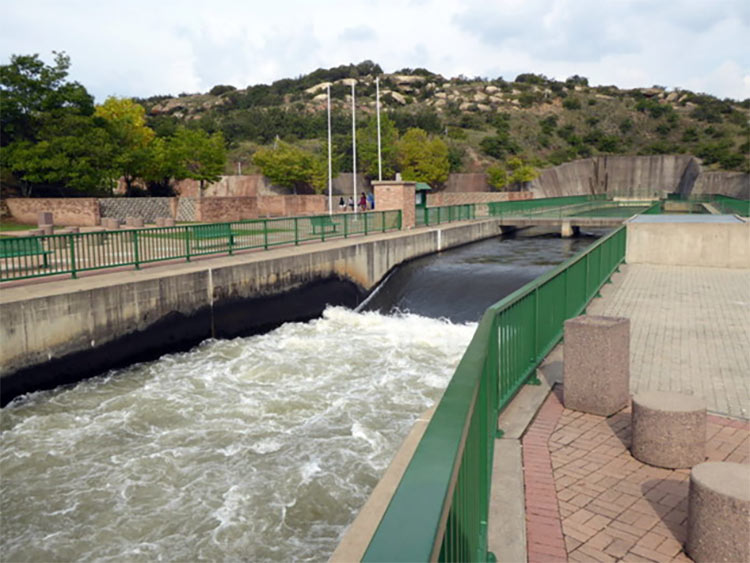Lesotho advancing Polihali diversion works 12 Nov 2020
Excavation is advancing to divert the Senqu River ahead of construction of the concrete-faced rockfill Polihali dam as part of the Lesotho Highlands Water Project Phase II in southern Africa. Drill+blast excavation of the twin diversion tunnels of 7m and 9m diameter and 1km long, is advancing from the outlet portals and at about 6m/day in each heading.
Excavation of the intake and outlet portals has been completed. Work on the concrete lining is underway with concrete casting and reinforcement having been started in one of the tunnels. Both intake and outlet portals have been supported with sprayed concrete and rockbolts and preparatory works for concrete works for the inlet structures are also ongoing.
The tunnels are being excavated as a separate contract by the SCLC JV and in advance of the Polihali Dam contract award to reduce its construction period. SCLC comprises Salini Impregilo, CMC di Ravenna, LSP Construction Lesotho, and CMI Infrastructure, South Africa. The works are designed and being supervised by the Metsi a Senqu-Khubelu Consultants of South African- and Lesotho-based firms including Zutari, Knight Piesold, Hatch Goba, SMEC and FM Associates.
Work on site got off to a slow start in early 2020 , due to Covid-19 restrictions that restricted shift work and reduced the number of workers to enable social distancing. Continued border restrictions between Lesotho and South Africa also posed travel challenges for South African-based technicians and the movement of equipment and supplies.
Lesotho imposed lockdown restriction at the end of March, which effectively halted Phase II construction work. These were partially lifted on in early May, allowing businesses to open and contractors based in the country to resume operations once they had implemented the necessary COVID-19 safety. The protocols took time to implement and include:
- Strict access control measures, including temperature measurement and recording personal details of all who enter the job sites;
- Screening of workers coming back to site from COVID-19 hotspots;
- Limiting the entry of visitors and non-essential personnel to construction sites;
- Installation of sanitizer and hand washing points at strategic locations on sites;
- Regular and thorough disinfecting and cleaning of the workplace, ablution facilities and eating areas;
- Social distancing in workers’ accommodation;
- Compulsory wearing of face masks by all project staff;
- Limiting community meetings but where necessary, ensuring social distancing and the wearing of masks.
During the lockdown, LHDA continued to provide essential services including generation of electricity at the ‘Muela hydropower plant, transfer of water to South Africa, and disbursement of the annual compensation to project-affected communities. The borders with South Africa re-opened in early October, but with everyone permitted to enter Lesotho being screened to provide evidence of a negative PCR COVID-19 test within 72 hours of travel and to register a location for the compulsory quarantine period.
As the COVID-19 restrictions have been incrementally lifted since the beginning of May, and while the protocols and other restrictions remain in place, good progress is being made on the diversion tunnels and also on the access roads, bulk power and other aspects of the separate advanced infrastructure works contracts.
“As construction picks up on the diversion tunnels, the teams continue to observe the strict LHDA health and safety protocols to ensure that the work environment is safe for crews,” stated Tente Tente, Chief Executive of LHDA, the implementing and management authority of the Lesotho Highlands Water Project on behalf of the Government of Lesotho. “These protocols include airborne contaminant monitoring of the excavation works and monitoring of the work area temperature and air flow among other measures. The project invests heavily in safety measures and installed ventilation fans inside the tunnels in August.”
As excavation of the diversion tunnels progresses, procurement of the construction contracts for the Poliholi Dam and the 38km long x 5m diameter gravity tunnel to transfer water from the Poliholi reservoir to the existing Katse Dam reservoir, the centre piece of the LHWP Phase I, is also progressing. A prequalification process in 2019, that had identified shortlists for each contract has been cancelled and a new process has been initiated with a new call for interested groups to participated. JVs lead by Salini Impregilo were shortlisted for both contracts with other groups include contractors from China, South Africa, Lesotho, France, Brazil and Portugal.
Poliholi dam will be built downstream of the confluence of the Orange-Senqu and Khubelu Rivers in the Mokhotlong District of Lesotho to create a 2,325 million m³ capacity reservoir on the Orange and Khubelu Rivers over an area of 5,053 hectares. Impoundment of Polihali Reservoir is expected to commence in 2024 with water delivery to Katse reservoir planned to start in 2027.
The LHDA Phase II project augments the Phase I system which has been delivering specified quantities of water to South Africa since 2004 via an 85km long transfer and delivery tunnel to an outlet on the Ash River in South Africa and utilizing the delivery system to generate hydro-electric power in an underground power house at ‘Muela in Lesotho. Phase II will increase delivery under the international water delivery treaty from the 780 million m3 per year of Phase I to 1.37 billion m3 per year.
References
- Lesotho Phase II dam and tunnel shortlists – TunnelTalk, January 2020
- Lesotho appoints LHWP Phase II experts and calls prequalifications – TunnelTalk, January 2019
Lesotho Polihali diversion works awarded 25 Apr 2019
Excavation for Phase II of the Lesotho Highlands Water Project has set to start with award of the contract for the Polihali Dam diversion tunnels to the SCLC Polihali Diversion JV of the South African branches of Salini Impregilo and CMC di Ravenna of Italy with LSP Construction of Lesotho and CMI Infrastructure of South Africa.
The Maluti 517 million contract is for drill+blast excavation of parallel tunnels of about 1km long each, to divert the waters of the Senqu River around the dam construction site. Two tunnels, one of 7m in diameter and the other of 9m diameter, will increase the capacity to carry flood waters and provide flexibility to work in one tunnel while the river flows in the other.
The SCLC JV is expected to be on site without delay and the work is expected to be completed in about 18 months. The drill+blast tunnels will be supported by rockbolts and shotcrete as required.
The Metsi a Senqu-Khubelu Consultants JV, which also includes a number of South African and Lesotho-based firms including Aurecon, Knight Piesold, Hatch Goba, SMEC of South Africa, and FM Associates of Lesotho, has designed the diversion tunnels and will also supervise the construction work.
The Phase II water transfer component comprises a 165m high concrete-faced rockfill dam at Polihali and a 38km long x 5m diameter gravity tunnel that will connect the reservoir at Polihali with the existing project reservoir at Katse (Fig 1). Expressions of interest to pre-qualify for the construction of the Polihali Dam and the transfer tunnel closed in March 2019.

A 38km long transfer tunnel will link the new Polihali reservoir to the existing Phase I Katse reservoir
Phase II also includes a hydropower element to increase the quantity of electricity generated in Lesotho. Further feasibility studies into the Phase II hydro element have confirmed that conventional hydropower, rather than a pumped storage concept, is the preferred option and that three potential sites for the installation have been identified: two on the Senqu River and one at Oxbow (Fig 1). Studies on these three options are being taken to bankability stage.
The elements of Phase II of multi-phased, multi-billion Maloti/Rand Lesotho Highlands Water Project between the Governments of the Kingdom of Lesotho and the Republic of South Africa will increase incrementally the current 780 million m3 per annum supply of Phase I potable water to South Africa to more than 1,270 million m3 per annum. The new reservoir at Polihali and its transfer tunnel, with a proposed lake-tap outlet, will augment the water supply capacity from the existing Katse reservoir to meet the increased delivery. The further feasibility studies of the hydropower component of Phase II for Lesotho are close to completion.
“Construction of the diversion tunnels is an important element of the advance infrastructure works that started at the end 2018 with the award of contracts for the Polihali North East Access road and for civils work required at the existing Katse and the planned Polihali reservoir sites,” said Tente Tente, Divisional Manager of the Lesohto Highlands Development Authority (LHDA). “The advance infrastructure will be largely completed before start of construction of the Polihali Dam and the Polihali to Katse water transfer tunnel.” LHDA is the implementing and management authority for the Lesotho Highlands Water Project on behalf of the Government of Lesotho.
References
- Lesotho appoints experts, calls prequalifications – TunnelTalk, January 2019
- Lesotho Highlands Phase II preparations – TunnelTalk, February 2018
- Chronicle of Phase I construction of the Lesotho Highlands Water Project
Lesotho Highlands Phase II preparations 22 Feb 2018
The rumble of construction activity is set to be heard once again high in the mountains of Lesotho as elements of Phase II of the binational water delivery project between Lesotho and neighbouring South Africa are developed towards a construction start within the coming years.
Phase II builds on the successful completion of Phase IA in 1998 and 1B in 2003 and includes excavation of an approximately 38km long x 5m diameter tunnel to transfer water by gravity from the new reservoir Polihali on the Senqu River in the Mokhotlong district into the existing Phase I Katse reservoir for delivery to South Africa via the existing Phase I tunnelled and run-of-river transfer scheme. Along with the new transfer tunnel, Phase II includes a new 165m high concrete-faced rockfill dam and a new measurement weir on the Senqu River and a proposed lake-tap outlet into the Katse reservoir.
Phase II of the treaty-controlled delivery of water from the highlands of Lesotho to the Vaal Dam in South Africa is needed to increase current delivery of the Phase I scheme to meet increasing demand for potable water in the Gauteng region of South Africa that includes the cities of Johannesburg and Pretoria and the industrial powerhouses that they support. The transfer system also generates hydro-electricity for Lesotho.
Development of Phase II has been progressing since Phase I was completed, and in late 2017, the Lesotho Highlands Development Authority (LHDA), the implementing and management authority for the Project on behalf of the Government of Lesotho, awarded the contract for designing and supervising the construction of the Polihali water transfer tunnel - the largest of the Phase II engineering design contracts - to the Metsi a Senqu-Khubelu Consultants (MSKC) Joint Venture.
The Authority is also recruiting leading professionals to a Panel of Experts to advise LHDA on the design, construction and procurement of the major civil works of the Phase II project, including development of proposed additional hydroelectric potential within the new scheme and advice on construction and contract law for major civil engineering projects. Applications for the panel close on 19 March 2018 (see the Procurement Notice for more details).
Work by the MSKC JV on the approximately Maluti/Rand 900 million, Phase II Polihali transfer tunnel design and construction supervision contract – the largest of the Phase II engineering design contracts – began in December 2017. The MSKC team comprises Lesotho-based FM Associates, and South African firms Aurecon South Africa, Hatch Africa, Knight Piesold and SMEC South Africa. Sub-consultants include White Life Consultants of Lesotho; S5 Construction Consultants of Lesotho; and ILISO Consulting of South Africa
“The appointment is a significant Phase II milestone,” said Lesotho Minister of Water Samonyane Ntsekele MP. “The MSKC JV combines local, regional and international tunnel experts, well qualified to deliver on the brief, within the timeframe, and to the highest standards.”
The scope of services includes reviewing the existing project information and preparing the preliminary design of the transfer tunnel; preparing the tender design, drawings and tender documents for the construction of the tunnel; supporting LHDA through the contract tender and award process; and providing contract management services during the construction of the tunnel.
Specialists on the proposed Panel of Experts will advise and assist LHDA in the design and construction disciplines of major bridges, concrete faced rockfill dams, tunneling and tunnel structures for water and hydropower projects; geology and geotechnical engineering, mechanical and electrical engineering for water and hydropower projects, and construction and contract law.
The envisaged 38km long transfer tunnel will be designed to transfer water by gravity from from the Polihali reservoir into the Katse reservoir. Construction is expected to commence in 2020 and to be completed by the end of 2025. It is said that both TBM and drill+blast methods will be used to excavate the tunnel.
When completed by the 2025 due date, the elements of Phase II will progressively increase the current water supply rate per annum to South Africa from 780 million m3 to more than 1 270 million m3. At the same time, it will increase the quantity of electricity generated in Lesotho as a further step in securing a national independent electricity source.

The shielded TBM that completed the 5.38m o.d. Delivery Tunnel North in South Africa in 1995 stands as a monument near the outfall of the tunnel to the five TBMs that completed the 82km Phase IA Transfer and Delivery Tunnels and the two machines that completed the 32km Phase IB Mohale Interconnecting Tunnel
The major works of Phase I included the construction of the Katse Dam, the water transfer and delivery tunnels, ‘Muela Dam and ‘Muela Hydropower Plant, the Masuko weir and delivery tunnel, and the Mohale Dam and transfer tunnel (Fig 1). The Phase II water transfer component comprises a dam at Polihali and a gravity tunnel that will connect the reservoir at Polihali with the Katse Reservoir. The envisaged hydropower component will comprise the Kobong Pumped Storage Scheme, or a similar scheme, subject to agreement on current joint final feasibility studies.
In building on the legacy of the Phase IA and IB elements of the project, Phase II will add approximately 38km of water transfer tunnelling to the 82km completed under the Phase IA project and the 38.4km of Phase IB elements comprising:
Phase IA
Transfer Tunnel: 45km x 5m diameter excavated by 3 TBMs
Delivery Tunnel South: 15km x 5m diameter by 1 TBM
Delivery Tunnel North: 22km x 5m diameter by 1 TBM
Phase IB
Matsoku Transfer Tunnel: 6.4km x 4.5m diameter by drill+blast
Mohale Interconnection Tunnel: 32km x 3.4m diameter x 2 TBMs
When completed by the 2025 due date, the elements of Phase II will progressively increase the current water supply rate per annum to South Africa from 780 million m3 to more than 1 270 million m3. At the same time, it will increase the quantity of electricity generated in Lesotho as a further step in securing a national independent electricity source.
References
- Invitation for applications to the LHDA Engineering Panel of Experts – TunnelTalk, Procurement Notice
- Reports of the Phase IA and IB procurement and construction experience – TunnelTalk, Books & Reports
|
|
|
|
|
Add your comment
- Thank you for taking the time to share your thoughts and comments. You share in the wider tunnelling community, so please keep your comments smart and civil. Don't attack other readers personally, and keep your language professional.









